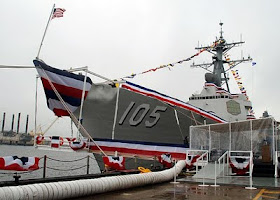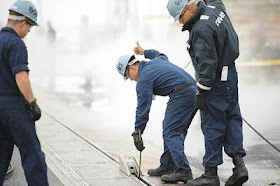By Oyaol Ngirairikl, Joint Region Marianas Public Affairs
SANTA RITA, Guam (NNS) -- Providing dual-oceanic communication support, multiple networks, and high frequency support for the fleet and joint military components makes U.S. Naval Computer and Telecommunications Station (NCTS) Guam paramount for mission success in and around the region of Guam.
"Ensuring ships, subs and shore commands are able to communicate messages from the Indian Ocean to the Pacific is just one of the things we do here," said Cmdr. Willis Arnold, executive officer of NCTS Guam. "NCTS — because of its location on Guam — is very strategic because it's situated so that we can hit two oceans, Pacific and Indian, from this location. So as a result of this, you can relay information between two ships or between a ship and a land command in two different oceans — that's a very unique ability and that makes us a very valuable commodity."
The command has about 200 personnel — a mix of military service members, civilians and contractors.
"We are a small command with a very large job and the scope of our communications is bigger than Guam," said Chief Information Technician (SW) Eric Purcell information assurance officer.
NCTS Guam is one of seven Navy computer and telecommunications stations that provides assured communications services to shore and afloat units worldwide. NCTS Guam is a round-the-clock operation that has three primary mission areas:
• Multispectral connectivity to the warfighter. This is the traditional role people think of when they think of an NCTS, such as the antennae that send communications to ships, submarines and airplanes.
• NCTS Guam provides critical communication lines to Navy, Air Force, Coast Guard, joint and coalition operations to include search and rescue. Base Communications Office. This function is the telephone service and island-wide transport of communication services on Guam. NCTS provides the telephone services for all Navy and many other customers on Guam.
• NET Ops and Information Assurance. NCTS Guam provides the local help desk and support for 24 Navy units as the local ONE-NET enterprise network service provider. NCTS provides touch labor and help desk support to over 3,000 ONE-NET computers on Guam. In addition, NCTS Guam is the cryptographic service provider for 29 units on Guam, providing electronic cryptographic material support.
The primary facility consists of a group of buildings and satellites tucked just beneath Andersen Air Force Base in the northern end of Guam. Yet, the command has offices around the island, including Radio Barrigada, a centrally located village of Guam, which has what looks like a dozen antennae sticking up above the surrounding roads and fields. In addition, NCTS employees and contractors attached to the command have an office on U.S. Naval Base Guam.
Arnold said two of the primary goals he and Cmdr. William Chase, NCTS commanding officer, have set for the command are to revitalize the "operational focus of the command" and to implement strict information assurance practices at the command in accordance with Defense Information Systems Agency (DISA) standards.
"One challenge with implementing strict information assurance practices is the need for full cooperation from all of our customer units," Arnold said. "This goal was realized in the development of the Navy Region Guam Security Counsel, which met weekly preparing for the Defense Information Systems Agency command computer readiness inspection."
Arnold noted the cooperative efforts of all Navy units utilizing ONE-NET computer assets, resulted in a highly successful 2009 DISA inspection, with the lead inspector stating "this is the best network security posture we have seen in 16 years. Outstanding team effort by Navy Region Guam."
Arnold also noted that a large percentage of NCTS personnel are civilians and contractors, which provide continuity.
"NCTS Guam [contractors and civilians have] had and continue to have a very positive impact on operations," Arnold said. "While it does take the entire team of military, federal employees, and contractors to get the mission accomplished, the civilian and contract employees provide the continuity of operations to effect a more efficient organization."
In addition, many members of the civilian and contractor work force bring with them years of military experience. Terry Morgan is one example. Morgan was an electronics technician in the Navy for 20 years and is now one of the civilians working alongside uniformed service members.
"We didn't even have e-mail when I first started doing this," Morgan said. "Now we've got different levels of e-mails that comes through here."
Robert Laanan, a sergeant major in the Guam Army National Guard, is now NCTS' DISN services manager who takes a lot of pride in the work he does to keep the island's and region's Navy commands connected to each other and to the world.
"We were the first Guam telephone authority," he said. "It was the Navy that built the telephone systems that we were all using, and eventually all of that went to government of Guam, and now of course it's private. But this is where it all started — how Guam was able to talk to the rest of the world — and here is where we keep it going for the present and hopefully into the future."
Arnold noted that in addition to the benefits of having experienced civilian personnel that provide continuity, the mix of military, civilian and contractor helps to ensure quality work is completed efficiently and economically.
"The great thing is as the Navy strives to economize while maintaining professionalism and technological expertise, we can say we've been doing that here," Arnold said.
Echoing Laanan, Arnold said the men and women of NCTS Guam have "extreme pride in the work they do every day to support missions on Guam."
"There is a tremendous amount of loyalty and dedication to NCTS and the United States Navy by the team of military, Department of Navy employees, and contract personnel who support NCTS Guam," he said.



















